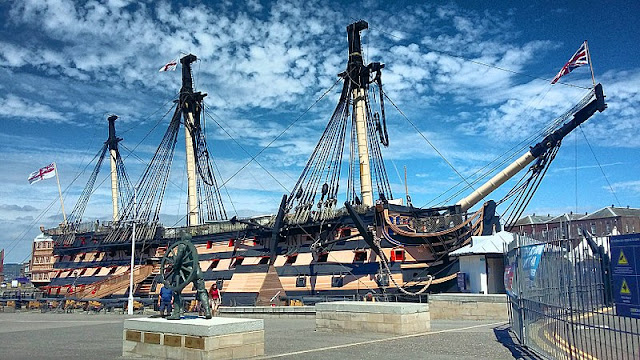 |
| A self-made man. |
To these ends, crews on Royal Navy warships would get one "afternoon off" each week for such "make and mend" work: the construction of new items of clothing, often from spare bits of canvas cribbed or purchased from the sailmaker or his mate, or the repair of existing clothing. All save the newest, perhaps impressed, crew would have the cutting and sewing skills necessary to create reasonably tidy clothing, and which would, while remaining individualized, hew to the general look of "seaman's rig".
 |
| Such skills as might be required after these sort of fun and games. |
 |
| Improved the grog, too. |
Which brings us to the ideal of self-sufficiency and the reality of "only so much boat". The Royal Navy, tasked with the defense (or often the acquisition) of a vast, disjointed empire, had at its disposal ships constantly in a state of rot, cannon and musket-fire damage, and the material weakenings of sea, sun and wind. Depots of trained craftsmen, shipwrights and labourers, along with hard-to-transport materials such as masts, planks and cannon, had to exist in remote areas. Ships on dreaded blockade duty spent months and even years on station without "refit", getting occasional resupply at sea even as planks were sprung and sails were shredded. Other ships would cruise thousands of miles from the closest naval bases, and had to bring many tons of canvas, lines of every description, metal plate and ingots and the means to forge them, along with food and drink sufficient to keep large crews alive, if not particularly well-fed.
 |
| "Out of Madeira? The deuce you say, sir!" |
The limit of wooden warship construction was some 200 feet/60 metres LOA. Larger ships would "hog" or sag under their own weight. Taller ships might and did capsize due to the weight of cannons carried too high. Nonetheless, given relatively strict limitations, it was not unusual for a medium-sized warship, such as a frigate or a third-rate "74", to be on patrol for a year or more without more than going ashore to fill water casks or to obtain a few animals for on-deck slaughter.
Royal Navy warships were thus functionally autonomous. Only the more severe sort of damage, such as a holing below the waterline, or losing the mainmast, would necessitate an unplanned trip to a naval base. It was this sort of logistical support that underpinned the ability of a warship to not "touch shore" for extended periods, and we as aspiring long-distance cruisers can learn from it.
 |
| Not as rare an event as one might wish, and sometimes absurdly difficult to get fixed/replaced. |
It's good to know, if somewhat discouraging, that it's hard to get your boat fixed in many places around the world, as cruisers Bruce and June on Ainia have recently learned. The old rueful saying that cruising is "boat repair in exotic places" is simply a function of the fact that the sea is a harsh environment that wears out gear faster and in more unusual ways than are typical ashore. That's why the Royal Navy helped to kick-start the Industrial Revolution by setting up block-making, rope-making, and shot-making (cannonball) factories, because every ship had to carry three or four "sets" of rigging, ground tackle, sails, shot, gunpowder and so on. Hemp rope and canvas sails rotted rapidly compared to modern materials, and while those materials are objectively more durable, even a modestly equipped 40 foot cruiser is arguably more complex in terms of systems than was HMS Victory at the battle of Trafalgar. Shown to even the captain of an 1805 warship, the average boat show floor model of today is akin to showing the cockpit of an Airbus to a World War 1 pilot. The general principles of operation under sail would be grasped, but little else.
 |
| A tribute to ruinously expensive maintenance and a willingness to carry spares meant "six months on blockade duty" |
Strangely, some cruisers stow six months' worth of food and, via the miracle of desalination, water, giving themselves the same "mission runtime" as HMS Victory. I think that it is possible to get away with not carrying quite so much food and even water as was common in the '60s and '70s, or to carefully plan to incorporate fishing and dehydrated/dry foodstuffs so as not to carry a half tonne of tins.
In other words, keep Antarctica off your route and there's few places you won't find some sort of grocery store. Spares, however, are a different story. We are spoilt for choice in the Western world, but more to the point, we are spoilt for access. I discovered on Friday that I had the wrong flange adapter for my Aquadrive universal coupler to mate with my Hurth ZF 25 2.0 hydraulic transmission. Yes, the preceding sentence was not intended for the casual reader. Nonetheless, I can phone the people who sold it to me, e-mail them pictures of what I'm talking about, and have the right part couriered to me in days, depending on how much I wish to pay for speed. There's no question it will happen.
Go to Random Tropical Paradise, however, or even Slightly Less First-world Democracy, and it's a different story. Dealers in obscure marine gear...or any marine gear...may not exist, or may have part-time hours, may be run as a sideline with little or no on-site stock, may be far from the port you have struggled to reach, or simply not exist in your charmingly underserved locale. The same trouble can involve sourcing machinists, fabricators, riggers, mechanics or those qualified to glass over the hole in the bow caused by hitting SOMETHING offshore.
So the question of "how many spares" is answered by "how much do you wish to spend" and "do you want to live in the middle of a boat gear shop?" You will never get "total coverage", and so must have Plan Bs as options: lost your pressure water? Fetch the foot pump or manual pump. Bent a fluke in a blow? Carry a backup primary anchor. Burnt out your windings or zapped a solenoid? Get a windup engine starter.
(Although after a "water event" in the boat in the summer of 2017, I ended up getting a spare typical starter.)
 |
| Worth bringing? That depends how far off the cluster points you intend to drift |
Fabrication can be considered a subset of spares, it seems to me. One would usually carry extra raw water pumps, even at $500 per, just as one would carry the many filter elements, clamps, belts, and lengths of hose and gasketing needed for the modern diesel. One is less likely to carry obscure tools, like prop pullers, or things like bar and plate in steel and aluminum, lengths of threaded SS rod, spools of tinned wire, reels (as opposed to just coils) of Dacron and Spectra line, wooden planks and boards, tap sets, vises, drill presses and light welding capacity. In other words, not just the spares anyone doing more than a weekender would do, but the means to make items that will serve as the spare, or will replace items for which no spare exists aboard, or perhaps, within reasonable space and time.
 |
| Welding? In my boat? It's more likely than you think. |
Now we're talking 18th century self-sufficiency with 21st-century gear! Ar, matey, indeed, she be floatin' below her lines, y'arr.
Along with all the other stuff I'm doing aboard to get launched in late April, I am designing the layout the forepeak workshop. As can be seen, we have a triangular space about seven feet long and eight feet across at the base (the collision bulkhead) to play with, and I have standing headroom. Due to a reader request, I've updated the design to that of 2016, which is about 75% completed at present, save for the anchor chain fall.
 |
| Enough to scale for planning purposes. |
So, in pursuit of the "fix it yourself while underway" goal, which I freely admit might be illusory, I am weighing the pros and cons of bringing 120 VAC contractor-grade power tools, the very tools I've been using in the refitting process. As mentioned before, the plan is to use one of two portable gensets to power them, and not to lean on the handy but somewhat wasteful DC-AC inverter. That item will run some computer gear, a small microwave and, when necessary, a little Shop-Vac action.
 |
| OK, this may represent overkill. |
Considering bringing small drill presses and stick/wire-feed welding equipment kicks things up a notch. It's a steel boat, after all, not something two-part epoxy can mend, and because I can see making brackets, mounts and other relatively simple pieces while aboard, I don't consider it unreasonable to have this capability. I already carry a selection of bar and plate stock, and can see, if a tang, for instance, went kablooey, making up a couple of straps to serve until I could obtain a proper casting would be a Good Thing.
It only seems pie-in-the-sky until one considers the alternative of being stuck in an under-serviced locale. I do agree that while it is impractical to carry a full range of spares, it may be possible to carry the means to fabricate simple items as temporary fixes. I must learn to weld, if only crudely, irrespective of bringing the means of production along with us; I have the room and the cost is not prohibitive, particularly when compared with the cost of staying tied up to a dock for weeks on end waiting for boat gear made of Pure Unobtainium to wend its merry way through customs, the bribery filter and dodgy postal services.
 |
| Available near your anchorage...maybe. |
I'm prepared to consider that I am overthinking this whole "floating machine shop" idea, but I've gotten quite used to having a number of tools, taps and whirring, grinding objects at hand and have difficulty contemplating not having that ability in some distant lagoon. The challenge will be finding the sweet spot between rational preparedness, capacity and realism about how much I actually will want to cover my repair needs (and maybe the repair needs of others) while on passage.





No comments:
Post a Comment